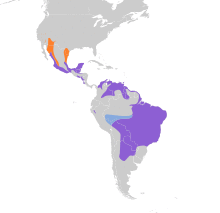| Brown-crested flycatcher | |
|---|---|
 | |
| At Piraju, São Paulo State, Brazil | |
| Scientific classification | |
| Kingdom: | Animalia |
| Phylum: | Chordata |
| Class: | Aves |
| Order: | Passeriformes |
| Family: | Tyrannidae |
| Genus: | Myiarchus |
| Species: | M. tyrannulus |
| Binomial name | |
| Myiarchus tyrannulus (Statius Müller, 1776) | |
 | |
The brown-crested flycatcher (Myiarchus tyrannulus) is a passerine bird in the tyrant flycatcher family.
Description
Adult brown-crested flycatchers are 20.3 cm (8.0 in) long and weigh 30 g (1.1 oz) and have heavy bills. The upperparts are olive brown, with a darker head and short crest. The breast is grey and the belly is lemon yellow. The brown tail feathers have rufous inner webs, the remiges have rufous outer webs, and there are two dull wing bars. The sexes are similar.
The brown-crested flycatcher is best separated from other confusingly similar Myiarchus species by its call, a rough loud "come HERE, come HERE" or "whit-will-do, whit-will-do".

Distribution and ecology
The brown-crested flycatcher breeds in open woodland from southern California, southern Nevada, central Arizona, and southern Texas southward to Argentina and Bolivia, and on Trinidad and Tobago.[1] It is resident in most of its range, but individuals breeding in the United States retreat to Mexico or southern Florida in winter.
This species is a rather skulking insectivore which catches its prey by flycatching amongst the undergrowth. It sometimes eats fruit, such as the "gumbo-limbo", Bursera simaruba.[2] The nest is built in a tree cavity or similar natural or man-made hole, and the normal clutch is two or three purple-marked cream eggs.
References
- ^ a b BirdLife International (2012). "Myiarchus tyrannulus". IUCN Red List of Threatened Species. 2012. Retrieved 26 November 2013.
- ^ Mercedes S. Foster (2007). "The potential of fruiting trees to enhance converted habitats for migrating birds in southern Mexico". Bird Conservation International. 17 (1): 45–61. doi:10.1017/S0959270906000554.
Further reading
- ffrench, Richard; O'Neill, John Patton; Eckelberry, Don R. (1991). A guide to the Birds of Trinidad and Tobago (2nd ed.). Ithaca, NY: Comstock Publishing. ISBN 978-0-8014-9792-6.
- Hilty, Steven L. (2003). Birds of Venezuela. Helm Identification Guides. London: Christopher Helm. ISBN 978-0-7136-6418-8.
External links
- "Brown-crested flycatcher media". Internet Bird Collection.
- Brown-crested flycatcher photo gallery at VIREO (Drexel University)
- Brown-crested flycatcher species account at Neotropical Birds (Cornell Lab of Ornithology)
- Interactive range map of Myiarchus tyrannulus at IUCN Red List maps
